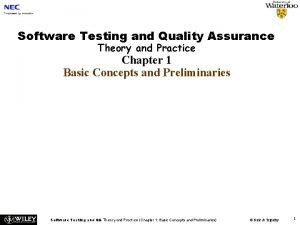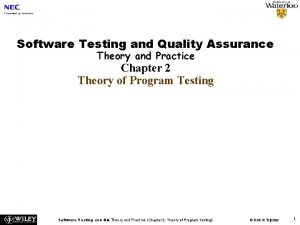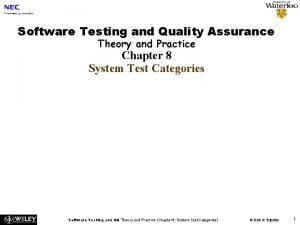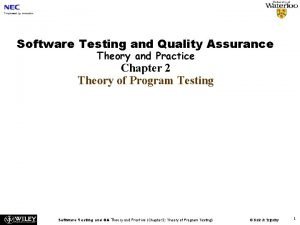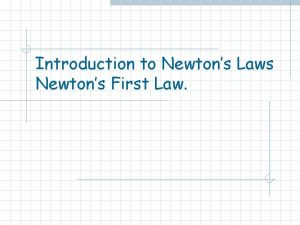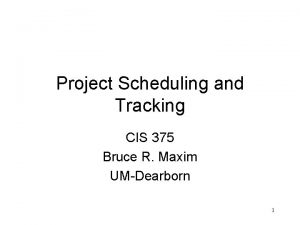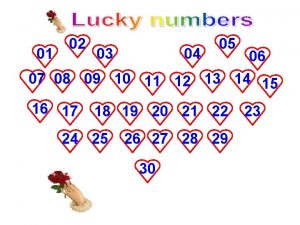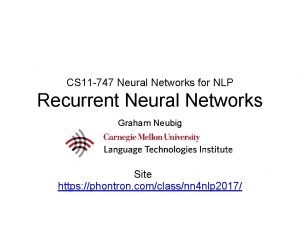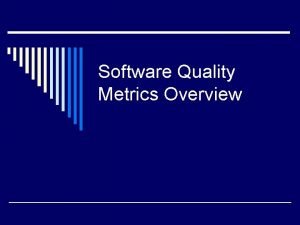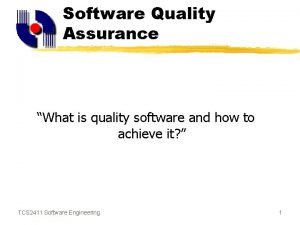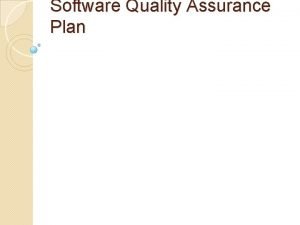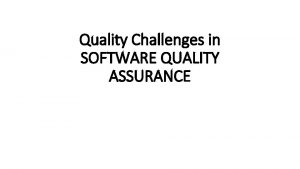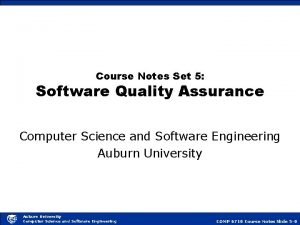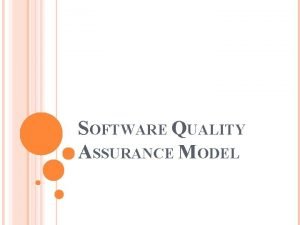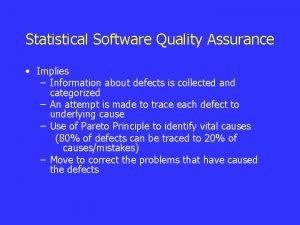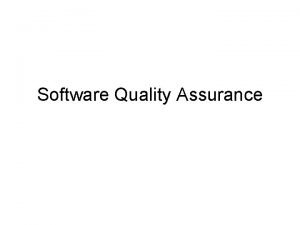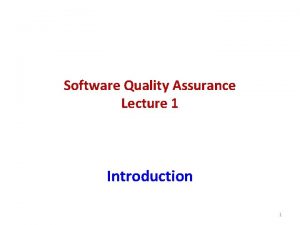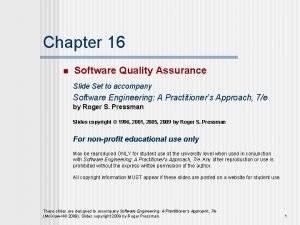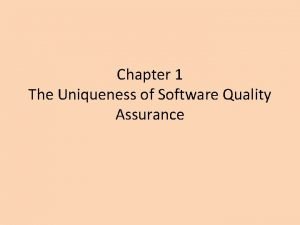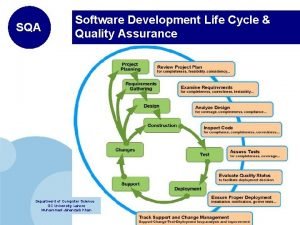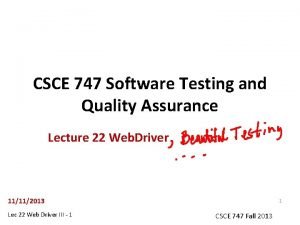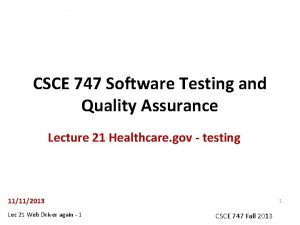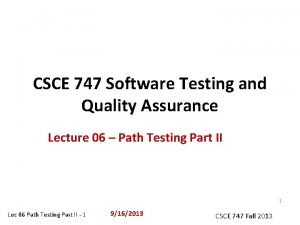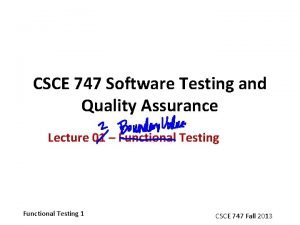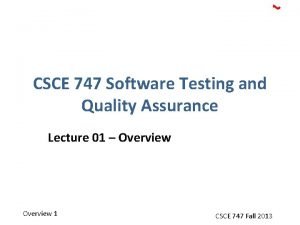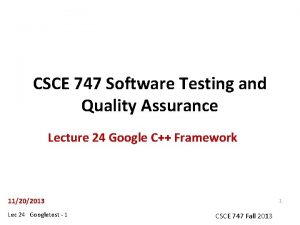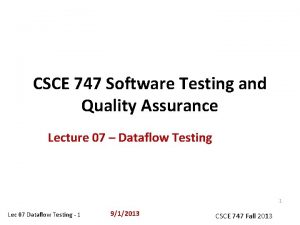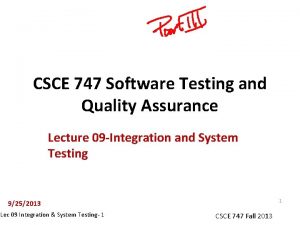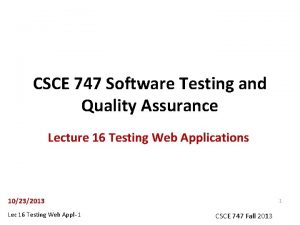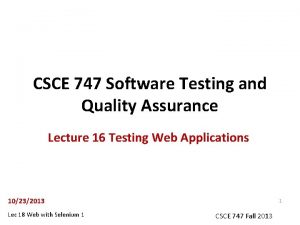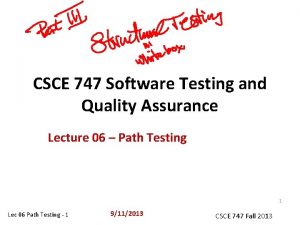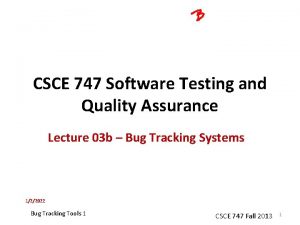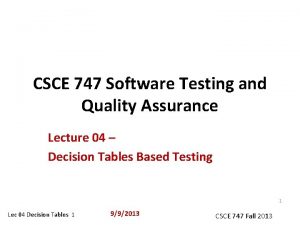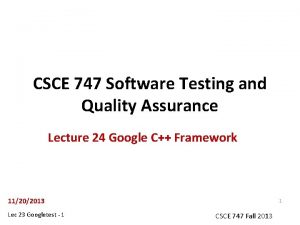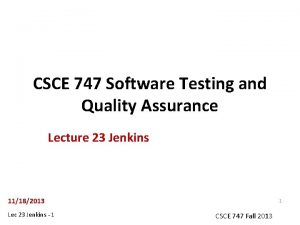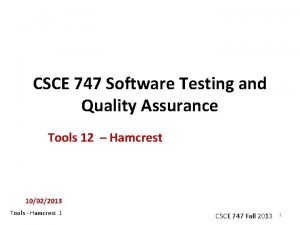CSCE 747 Software Testing and Quality Assurance Lecture






































![Java-Swing § What is the best testing tool for Swing-based applications? [closed] Lec 14 Java-Swing § What is the best testing tool for Swing-based applications? [closed] Lec 14](https://slidetodoc.com/presentation_image_h2/5c1e0b275926b7497fd389dbb2c25546/image-39.jpg)




















- Slides: 59

CSCE 747 Software Testing and Quality Assurance Lecture 14 Test Driven Object Oriented Design Example 10/16/2013 Lec 14 TDOOD-Example 1 1 CSCE 747 Fall 2013

1/7/2022 Last Time Today § Growing Object Oriented § Growing Object Software Oriented Software § Agile Manifesto Example: Snipper § Iterative Projects § Progress Tests vs Unit Tests § Start Testing with the Simplest Success Case § Unit-Test Behavior, Not Methods § Listen to the Tests § How Writing a Test First Helps the Design § The Tests Say § Only Mock Types That You Own Lec 14 TDOOD-Example 2 Jorgensen, Paul C. Software Testing A Craftsman Approach CSCE 747 Fall 2013 2

Write an Adapter Layer § If we don’t want to mock an external API, how can we test the code that drives it? § We will have used TDD to design interfaces for the services our objects need— which will be defined in terms of our objects’ Lec 14 TDOOD-Example 3 Growing Object-Oriented Software, Guided by Tests Freeman and Pryce CSCE 747 Fall 2013

Mock Application Objects in Integration Tests § As described above, adapter objects are passive, reacting to calls from our code. Sometimes, adapter objects must call back to objects from the application. § Event-based libraries, for example, usually expect the client to provide a callback object to be notified when an event happens. § In this case, the application code will give the adapter its own event callback (defined in terms of the application domain). § The adapter will then pass an adapter callback to the external library to receive external events and translate them for the application callback. Lec 14 TDOOD-Example 4 Growing Object-Oriented Software, Guided by Tests Freeman and Pryce CSCE 747 Fall 2013

Lec 14 TDOOD-Example 5 Growing Object-Oriented Software, Guided by Tests Freeman and Pryce CSCE 747 Fall 2013

Commissioning an Auction Sniper § we are commissioned to build an application that automatically bids in auctions. § We sketch out how it should work and what the major components should be. § We put together a rough plan for the incremental steps in which we will grow the application. Lec 14 TDOOD-Example 6 Growing Object-Oriented Software, Guided by Tests Freeman and Pryce CSCE 747 Fall 2013

Requirements: Terminology § Requirements discussions with customer and agree on some basic terms: § Item is something that can be identified and bought. § Bidder is a person or organization that is interested in buying an item price for an item. § Current price is the current highest bid for the item. § Stop price is the most a bidder is prepared to pay for an item. § Auction is a process for managing bids for an item. § Auction house is an institution that hosts auctions. Lec 14 TDOOD-Example 7 Growing Object-Oriented Software, Guided by Tests Freeman and Pryce CSCE 747 Fall 2013

Snipper: Java Swing application § run on a desktop and allow the user to bid for multiple items at a time. § It will show the identifier, stop price, and the current auction price and status for each item it’s sniping. § Buyers will be able to add new items for sniping through the user interface, and the display values will change in response to events arriving from the auction house Lec 14 TDOOD-Example 8 Growing Object-Oriented Software, Guided by Tests Freeman and Pryce CSCE 747 Fall 2013

First Draft of User Interface Lec 14 TDOOD-Example 9 Growing Object-Oriented Software, Guided by Tests Freeman and Pryce CSCE 747 Fall 2013

XMPP: the e. Xtensible Messaging and Presence Protocol Lec 14 TDOOD-Example 10 Growing Object-Oriented Software, Guided by Tests Freeman and Pryce CSCE 747 Fall 2013

Communicating with an Auction § The Auction Protocol - The protocol for messages between a bidder and an auction house is simple. § Bidders send commands, which can be: § Join - A bidder joins an auction. The sender of the XMPP message identifies the bidder, and the name of the chat session identifies the item. § Bid - A bidder sends a bidding price to the auction. § Price - An auction reports the currently accepted price. § Close - An auction announces that it has closed. The winner of the last price event has won the auction. Lec 14 TDOOD-Example 11 Growing Object-Oriented Software, Guided by Tests Freeman and Pryce CSCE 747 Fall 2013

Bidder – state machine Lec 14 TDOOD-Example 12 Growing Object-Oriented Software, Guided by Tests Freeman and Pryce CSCE 747 Fall 2013

Getting it Started § We can cut through this “first-feature paradox” by splitting it into two smaller problems. § First, work out how to build, deploy, and test a “walking skeleton, ” then § use that infrastructure to write the acceptance tests for the first meaningful feature. Lec 14 TDOOD-Example 13 Growing Object-Oriented Software, Guided by Tests Freeman and Pryce CSCE 747 Fall 2013

The Walking Skeleton § A “walking skeleton” is an implementation of the thinnest possible slice of real functionality that we can automatically build, deploy, and test end-to-end Lec 14 TDOOD-Example 14 Growing Object-Oriented Software, Guided by Tests Freeman and Pryce CSCE 747 Fall 2013

Deciding the Shape of the Walking Skeleton § context of the first test Lec 14 TDOOD-Example 15 Growing Object-Oriented Software, Guided by Tests Freeman and Pryce CSCE 747 Fall 2013

Prioritize Initial Requirements 1. Single item: join, lose without bidding § This is our starting case where we put together the core infrastructure. 2. Single item: join, bid, and lose § Add bidding to the basic connectivity. 3. Single item: join, bid, and win - Distinguish who sent the winning bid. 4. Show price details - Start to fill out the user interface. 5. Multiple items - Support bidding for multiple items in the same application. 6. Add items through the user interface Implement input via the user interface. 7. Stop bidding at the stop price - More intelligence in the Sniper algorithm. Lec 14 TDOOD-Example 16 Growing Object-Oriented Software, Guided by Tests Freeman and Pryce CSCE 747 Fall 2013

Iteration Zero § In most Agile projects, there’s a first stage where the team is doing initial analysis, setting up its physical and technical environments, and otherwise getting started. § The team isn’t adding much visible functionality since almost all the work is infrastructure § call this step iteration zero: § “iteration” because the team still needs to time-box its activities and § “zero” because it’s before functional development starts in iteration one. § One important task for iteration zero is to use the walking skeleton to test-drive the initial architecture. Lec 14 TDOOD-Example 17 Growing Object-Oriented Software, Guided by Tests Freeman and Pryce CSCE 747 Fall 2013

Our First Test § The thinnest slice we can imagine testing is that the Auction Sniper can § join an auction and then § wait for it to close § start by writing a test as if its implementation already exists, and then filling in whatever is needed to make it work— what Abelson and Sussman call “programming by wishful thinking” Lec 14 TDOOD-Example 18 Growing Object-Oriented Software, Guided by Tests Freeman and Pryce CSCE 747 Fall 2013

What First; then How § focus on what we want the system to do § instead of getting caught up in the complexity of how we will make it work Lec 14 TDOOD-Example 19 Growing Object-Oriented Software, Guided by Tests Freeman and Pryce CSCE 747 Fall 2013

A First Test: join, lose 1. When an auction is selling an item, 2. And an Auction Sniper has started to bid in that auction, 3. Then the auction will receive a Join request from the Auction Sniper. 4. When an auction announces that it is Closed, 5. Then the Auction Sniper will show that it lost Lec 14 TDOOD-Example 20 Growing Object-Oriented Software, Guided by Tests Freeman and Pryce CSCE 747 Fall 2013

Requirements Feedback Lec 14 TDOOD-Example 21 Growing Object-Oriented Software, Guided by Tests Freeman and Pryce CSCE 747 Fall 2013

State Machine Lec 14 TDOOD-Example 22 Growing Object-Oriented Software, Guided by Tests Freeman and Pryce CSCE 747 Fall 2013

Stub for Online Auction § Southabee’s On-Line test services are not freely available. § book ahead and § pay for each test session § We’ll need a fake auction service, a stub § § simple as we can make it. connect to an XMPP message broker receive commands from the Sniper and allow the test to send back events. Lec 14 TDOOD-Example 23 Growing Object-Oriented Software, Guided by Tests Freeman and Pryce CSCE 747 Fall 2013

Test 1 Lec 14 TDOOD-Example 24 Growing Object-Oriented Software, Guided by Tests Freeman and Pryce CSCE 747 Fall 2013

Auction Stub § We need to find or write four components: 1. an XMPP message broker, 2. a stub auction that can communicate over XMPP, 3. a GUI testing framework, and 4. a test harness that can cope with our multithreaded, asynchronous architecture. Lec 14 TDOOD-Example 25 Growing Object-Oriented Software, Guided by Tests Freeman and Pryce CSCE 747 Fall 2013

End-to-End Test Rig Lec 14 TDOOD-Example 26 Growing Object-Oriented Software, Guided by Tests Freeman and Pryce CSCE 747 Fall 2013

Window Licker § A framework for the test-driven development of Java systems through the GUI. § Features § Provides a high-level API for controlling and making assertions about graphical user interfaces: § Swing § Dynamic HTML (aka "AJAX") including GWT § Deals with the asynchronous nature of GUI and AJAX programming so the tests don't have to § Controls the GUI by sending native mouse and keyboard events § Handles different keyboard layouts § Produces high quality error messages to help you easily diagnose test failures § Easily extensible to cope with new user interface components Lec 14 TDOOD-Example 27 https: //code. google. com/p/windowlicker/ CSCE 747 Fall 2013

Application Runner Lec 14 TDOOD-Example 28 Growing Object-Oriented Software, Guided by Tests Freeman and Pryce CSCE 747 Fall 2013

Lec 14 TDOOD-Example 29 Growing Object-Oriented Software, Guided by Tests Freeman and Pryce CSCE 747 Fall 2013

Lec 14 TDOOD-Example 30 Growing Object-Oriented Software, Guided by Tests Freeman and Pryce CSCE 747 Fall 2013

Fake Auction Server Lec 14 TDOOD-Example 31 Growing Object-Oriented Software, Guided by Tests Freeman and Pryce CSCE 747 Fall 2013

A Minimal Fake Implementation Lec 14 TDOOD-Example 32 Growing Object-Oriented Software, Guided by Tests Freeman and Pryce CSCE 747 Fall 2013

Lec 14 TDOOD-Example 33 Growing Object-Oriented Software, Guided by Tests Freeman and Pryce CSCE 747 Fall 2013

Lec 14 TDOOD-Example 34 Growing Object-Oriented Software, Guided by Tests Freeman and Pryce CSCE 747 Fall 2013

X-windows § § Client-server graphics server runs remote clients events § mouse click, movement § keyboard press § callbacks Lec 14 TDOOD-Example 35 http: //en. wikipedia. org/wiki/X_Window_System_ protocols_and_architecture CSCE 747 Fall 2013

X-windows Design principles Bob Scheifler and Jim Gettys set out the early principles of X § Do not add new functionality unless an implementor cannot complete a real application without it. § It is as important to decide what a system is not as to decide what it is. Do not serve all the world's needs; rather, make the system extensible so that additional needs can be met in an upwardly compatible fashion. § The only thing worse than generalizing from one example is generalizing from no examples at all. § If a problem is not completely understood, it is probably best to provide no solution at all. § If you can get 90 percent of the desired effect for 10 percent of the work, use the simpler solution. (See also Worse is better. ) § Isolate complexity as much as possible. § Provide mechanism rather than policy. In particular, place user interface policy in the clients' hands. Lec 14 TDOOD-Example 36 http: //en. wikipedia. org/wiki/X_Window_System_ protocols_and_architecture CSCE 747 Fall 2013

X-windows § the client and the server exchange four types of packets : § Request: the client requests information from the server or requests it to perform an action. § Reply: the server responds to a request. Not all requests generate replies. § Event: the server sends an event to the client, e. g. , keyboard or mouse input, or a window being moved, resized or exposed. § Error: the server sends an error packet if a request is invalid. Since requests are queued, error packets generated by a request may not be sent immediately. § The X server provides a set of basic services. The client programs realize more complex functionalities by interacting with the server. Lec 14 TDOOD-Example 37 http: //en. wikipedia. org/wiki/X_Window_System_ protocols_and_architecture CSCE 747 Fall 2013

X-windows § § § § Windows Identifiers Attributes and properties Events Color modes Xlib and other client libraries Selections, cut buffers, and drag-and-drop Window manager Lec 14 TDOOD-Example 38 http: //en. wikipedia. org/wiki/X_Window_System_ protocols_and_architecture CSCE 747 Fall 2013
![JavaSwing What is the best testing tool for Swingbased applications closed Lec 14 Java-Swing § What is the best testing tool for Swing-based applications? [closed] Lec 14](https://slidetodoc.com/presentation_image_h2/5c1e0b275926b7497fd389dbb2c25546/image-39.jpg)
Java-Swing § What is the best testing tool for Swing-based applications? [closed] Lec 14 TDOOD-Example 39 http: //en. wikipedia. org/wiki/X_Window_System_ protocols_and_architecture CSCE 747 Fall 2013

Testing Swing Applications Lec 14 TDOOD-Example 40 http: //www. coderanch. com/t/95772/Testing/Test ing-Swing-Applications CSCE 747 Fall 2013

Lec 14 TDOOD-Example 41 CSCE 747 Fall 2013

Lec 14 TDOOD-Example 42 CSCE 747 Fall 2013

Unit Testing Guis § An important part of Unit. Testing. Guis is not to have to. Seriously, GUIs should be as thin and contain as little logic as possible. If the GUI additionally is only loosely coupled to the business logic (via Model. View. Controller? or Model. View. Presenter? ), Unit. Testing. Guis should become rather simple. A good example on testing Swing UIs with pure JUnit can be found at http: //www. xp 123. com/xplor/xp 0001/index. shtml § If you still need to write more complicated tests, take a look at http: //jfcunit. sourceforge. net/ Lec 14 TDOOD-Example 43 http: //www. coderanch. com/howto/java/Unit. Testing. Guis CSCE 747 Fall 2013

http: //xp 123. com/articles/thetestcode-cycle-in-xp-part-2 -gui/ § developing a simple search engine § develop and test the model first Lec 14 TDOOD-Example 44 CSCE 747 Fall 2013

public class Searcher. Factory { public static Searcher get(String s) throws IOException {. . . } } public interface Searcher { public Result find(Query q); } public class Query { public Query(String s) {. . . } public String get. Value() {. . . } } Lec 14 TDOOD-Example 45 CSCE 747 Fall 2013

public interface Result { public int get. Count(); public Document get. Item(int i); } public interface Document { public String get. Author(); public String get. Title(); public String get. Year(); } Lec 14 TDOOD-Example 46 CSCE 747 Fall 2013

The GUI Connection What we'd like to happen: § a searcher is associated with the GUI § a query is entered § the button is clicked § the table fills up with the result Lec 14 TDOOD-Example 47 CSCE 747 Fall 2013

Testing Key Widgets § We proposed a screen design earlier. The first thing we can test is that key widgets are present: a label, a query field, a button, and a table. There may be other components on the panel (e. g. , sub-panels used for organization), but we don't care about them. § So, we'll create test. Widgets. Present(). To make this work, we need a panel for the overall screen ("Search. Panel"), the label ("search. Label"), a textfield for entering the query ("query. Field"), a button ("find. Button"), and a table for the results ("result. Table"). We'll let these widgets be packageaccess, so our test can see them. Lec 14 TDOOD-Example 48 CSCE 747 Fall 2013

public void test. Widgets. Present() { Search. Panel panel = new Search. Panel(); assert. Not. Null(panel. search. Label); assert. Not. Null(panel. query. Field); assert. Not. Null(panel. find. Button); assert. Not. Null(panel. result. Table); } Lec 14 TDOOD-Example 49 CSCE 747 Fall 2013

Things to notice: § The test helped design the panel's (software) interface. § The test is robust against even dramatic rearrangements of the widgets. § We took very small steps, bouncing between test, code, and design. § Our panel might not (and in fact, does not) actually display anything – we haven't tested that. § The panel still doesn't do anything (e. g. , if the button were clicked). Lec 14 TDOOD-Example 50 CSCE 747 Fall 2013

public void test. Initial. Contents() { Search. Panel sp = new Search. Panel(); assert. Equals("Search: ", sp. search. Label. get. Text()); assert. Equals("", sp. query. Field. get. Text()); assert. Equals("Find", sp. find. Button. get. Text()); assert("Table starts empty", sp. result. Table. get. Row. Count() == 0); } Lec 14 TDOOD-Example 51 CSCE 747 Fall 2013

Testing Interconnection public void test. Searcher. Setup() { Searcher s = new Searcher() { public Result search(Query q) { return null; } }; Search. Panel panel = new Search. Panel(); assert ("Searcher not set", panel. get. Searcher() != s); panel. set. Searcher(s); assert("Searcher now set", panel. get. Searcher() == s); } Lec 14 TDOOD-Example 52 CSCE 747 Fall 2013

Testing with a Fake Searcher public void test. Test. Searcher() { assert. Equals(new Query("1"). get. Value(), "1"); Document d = new Test. Document(1); assert. Equals("y 1", d. get. Year()); Result tr = new Test. Result(2); assert(tr. get. Count() == 2); assert. Equals("a 0", tr. get. Item(0). get. Author()); } Test. Searcher ts = new Test. Searcher(); tr = ts. find(ts. make. Query("2")); assert("Result has 2 items", tr. get. Count() == 2); assert. Equals("y 1", tr. get. Item(1). get. Year()); Lec 14 TDOOD-Example 53 http: //xp 123. com/articles/the-testcodecycle-in-xp-part-2 -gui/ CSCE 747 Fall 2013

public class Test. Document implements Document { int count; public Test. Document(int n) {count = n; } public String get. Author() {return "a" + count; } public String get. Title() {return "t" + count; } public String get. Year() {return "y" + count; } } Lec 14 TDOOD-Example 54 http: //xp 123. com/articles/the-testcodecycle-in-xp-part-2 -gui/ CSCE 747 Fall 2013

Adapter Stub public class Result. Table. Adapter extends Default. Table. Model { public Result. Table. Adapter(Result r) {} } Lec 14 TDOOD-Example 55 http: //xp 123. com/articles/the-testcodecycle-in-xp-part-2 -gui/ CSCE 747 Fall 2013

Adapter Implementation Test First public void test. Result. Table. Adapter() { Result result = new Test. Result(2); Result. Table. Adapter rta = new Result. Table. Adapter(result); assert. Equals("Author", rta. get. Column. Name(0)); assert. Equals("Title", rta. get. Column. Name(1)); assert. Equals("Year", rta. get. Column. Name(2)); assert("3 columns", rta. get. Column. Count() == 3); assert("Row count=2", rta. get. Row. Count() == 2); assert. Equals("a 0", rta. get. Value. At(0, 0). to. String()); assert. Equals("y 1", rta. get. Value. At(1, 2). to. String()); } Lec 14 TDOOD-Example 56 http: //xp 123. com/articles/the-testcodecycle-in-xp-part-2 -gui/ CSCE 747 Fall 2013

public class Result. Table. Adapter extends Abstract. Table. Model implements Table. Model { final static String column. Names[] = {"Author", "Title", "Year"}; Result my. Result; public Result. Table. Adapter(Result r) {my. Result = r; } public String get. Column. Name(int i) {return column. Names[i]; } public int get. Column. Count() {return column. Names. length; } public int get. Row. Count() {return my. Result. get. Item. Count(); } public Object get. Value. At(int r, int c) { Document doc = my. Result. get. Item(r); switch(c) { case 0: return doc. get. Author(); case 1: return doc. get. Title(); case 2: return doc. get. Year(); default: return "? "; } Lec 14 TDOOD-Example 57 http: //xp 123. com/articles/the-testcodecycle-in-xp-part-2 -gui/ CSCE 747 Fall 2013

Testing for Looks § We have a properly connected panel. We can check the widgets' relative locations: § label left-of query. Field § query. Field left-of find. Button § query. Field above table Lec 14 TDOOD-Example 58 http: //xp 123. com/articles/the-testcodecycle-in-xp-part-2 -gui/ CSCE 747 Fall 2013

Testing for Looks public void test. Relative. Position() { Search. Panel sp = new Search. Panel(); JFrame display = new JFrame("test"); display. get. Content. Pane(). add(sp); display. set. Size(500, 500); display. set. Visible(true); //try {Thread. sleep(3000); } catch (Exception ex) {} assert ("label left-of query", sp. search. Label. get. Location. On. Screen(). x < sp. query. Field. get. Location. On. Screen(). x); … Lec 14 TDOOD-Example 59 http: //xp 123. com/articles/the-testcodecycle-in-xp-part-2 -gui/ CSCE 747 Fall 2013
 Quality assurance theory
Quality assurance theory Software testing and quality assurance: theory and practice
Software testing and quality assurance: theory and practice Software testing and quality assurance theory and practice
Software testing and quality assurance theory and practice Software testing and quality assurance theory and practice
Software testing and quality assurance theory and practice Quality assurance theory
Quality assurance theory Quality control and quality assurance
Quality control and quality assurance Basic concept of quality management
Basic concept of quality management Qat quality assurance testing
Qat quality assurance testing Newton law
Newton law Quality control vs quality assurance pmp
Quality control vs quality assurance pmp Pmp gold plating
Pmp gold plating Quality assurance cycle in nursing
Quality assurance cycle in nursing Quality improvement vs quality assurance
Quality improvement vs quality assurance Software quality assurance tools and techniques
Software quality assurance tools and techniques Project scheduling and tracking software quality assurance
Project scheduling and tracking software quality assurance Mr brown receives a salary
Mr brown receives a salary 11-747 neural networks for nlp
11-747 neural networks for nlp Oceanic airlines 777
Oceanic airlines 777 Sga-429
Sga-429 Types of software quality metrics
Types of software quality metrics Iso 9001 software quality assurance
Iso 9001 software quality assurance Sqa plans
Sqa plans Software quality challenges
Software quality challenges Software quality assurance conference
Software quality assurance conference Software quality assurance notes
Software quality assurance notes Software quality assurance models
Software quality assurance models Statistical quality assurance in software engineering
Statistical quality assurance in software engineering Statistical software quality assurance
Statistical software quality assurance Defect amplification and removal in software engineering
Defect amplification and removal in software engineering Engineering contract review process
Engineering contract review process Introduction to software quality assurance
Introduction to software quality assurance Software quality assurance framework
Software quality assurance framework Software quality assurance slideshare
Software quality assurance slideshare Uniqueness of software quality assurance
Uniqueness of software quality assurance Software quality assurance agency
Software quality assurance agency Software quality assurance agency uk
Software quality assurance agency uk Domain testing in software testing
Domain testing in software testing Kv charts in software testing
Kv charts in software testing Du path testing
Du path testing Globalization testing example
Globalization testing example Language testing
Language testing Control structure testing in software engineering
Control structure testing in software engineering Decision table testing in software testing
Decision table testing in software testing Advantages and disadvantages of decision table
Advantages and disadvantages of decision table Decision table based testing in software testing
Decision table based testing in software testing Rigorous testing in software testing
Rigorous testing in software testing Testing blindness in software testing
Testing blindness in software testing Types of domain testing
Types of domain testing European standards and guidelines for quality assurance
European standards and guidelines for quality assurance 01:640:244 lecture notes - lecture 15: plat, idah, farad
01:640:244 lecture notes - lecture 15: plat, idah, farad Sdlc quality assurance
Sdlc quality assurance Whole blood quality control
Whole blood quality control Control chapter 10
Control chapter 10 Quotes on quality assurance
Quotes on quality assurance Contoh kasus quality assurance di rumah sakit
Contoh kasus quality assurance di rumah sakit Pharmacovigilance quality assurance
Pharmacovigilance quality assurance What is qc
What is qc Lqa quality assurance
Lqa quality assurance Principles of quality assurance
Principles of quality assurance International network for quality assurance agencies
International network for quality assurance agencies

